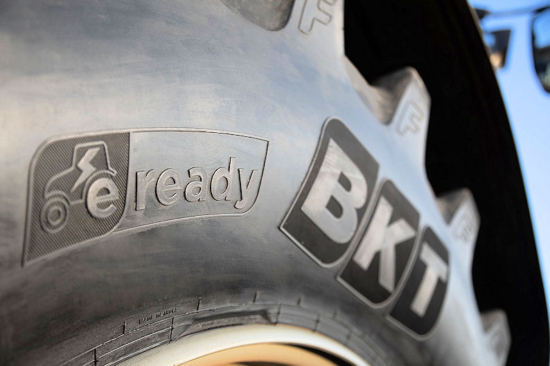Electromobility: BKT debuts E-Ready mark on Agrimaxfactor
 The E-Ready logo shows that a tyre is designed for EV use (Photo: BKT)
The E-Ready logo shows that a tyre is designed for EV use (Photo: BKT)
BKT wants us to know that it is “ready” for electric mobility in the off-highway segment, and is denoting products it has tailored for such vehicles with a new E-Ready sidewall logo. E-Ready made its debut at last November’s SIMA exhibition in Paris on the Agrimaxfactor 70 series tractor tyre range, and BKT plans to gradually extend its use to all products in this category.
“E-Ready specification represents a breakthrough, the beginning of a path toward delivering solutions suitable for electric mobility,” states BKT, adding that this designation “also aims to underscore BKT’s commitment to sustainability, a goal toward which every responsible business must direct research and investment.”
How does a tyre intended for an EV differ from a conventional one?
According to BKT, there are many differences. Trials and field tests have shown the tyre maker that in order to equip an electric vehicle, designers must take into account various factors that characterise electric mobility: weight, engine structure, range and noise.
Weight: Electric vehicles weigh more because their batteries may add up to 30 per cent extra weight, a factor that clearly affects how the tyre must work. The answer is greater stress resistance and thus a more robust structure, starting with reinforced belts and casing, to a different and specific sidewall and bead design.
Engine: Not only are they heavier, electric vehicles also move differently than vehicles running on natural gas or diesel: the vehicle immediately hits maximum power when the accelerator is pressed. This means that load shifts can be faster and more intense than in conventional vehicles, with a consequent effect on tyre wear. It is thus absolutely necessary to revisit the tyre’s bead structure to ensure better grip on the rim, especially during acceleration. The tread must also be optimised, both in terms of design and compound. Electrically powered vehicles have significantly more tyre wear than combustion engine vehicles, which is why a different design is needed to ensure an optimal lifecycle.
Range: Energy autonomy plays a decisive role. If an electric vehicle is designed for energy savings, tyres should also be designed with low rolling resistance in mind, as rolling resistance can contribute as much as 20 per cent of the vehicle’s energy consumption. In order to adjust the rolling resistance for electric vehicle tyres without compromising any other performance features, it is necessary to adapt the tread compound, tread pattern and also the sidewall structure.
Noise: Last but not least, manufacturers are investing heavily in research into vehicle/tyre consistency, including in terms of noise. Noise can be reduced through tread pattern and compound composition, while size also significantly contributes to a tyre’s quietness.
Investing in e-mobility
Thanks to its team of specialised researchers, BKT believes it has “developed the best solutions for the electric vehicle market through testing and prototyping.” Its first E-Ready tyre, the BKT Agrimaxfactor, will be followed by other products. BKT confirms it is “beginning to invest heavily in the e-mobility tyre segment.” The tyre maker shares that “while the centre of gravity of the goals may shift, innovation and a wide range remain the beacons guiding BKT into the future.”

 Rema Tip Top
Rema Tip Top

Comments